
Andrea Palladio was an Italian Renaissance architect active in the Venetian Republic. Palladio, influenced by Roman and Greek architecture, primarily Vitruvius, is widely considered to be one of the most influential individuals in the history of architecture. While he designed churches and palaces, he was best known for country houses and villas. His teachings, summarized in the architectural treatise, The Four Books of Architecture, gained him wide recognition.

Piazza di Spagna, at the bottom of the Spanish Steps, is one of the most famous squares in Rome, Italy. It owes its name to the Palazzo di Spagna, the seat of the Embassy of Spain to the Holy See. There is also the famed Column of the Immaculate Conception of the Blessed Virgin Mary.
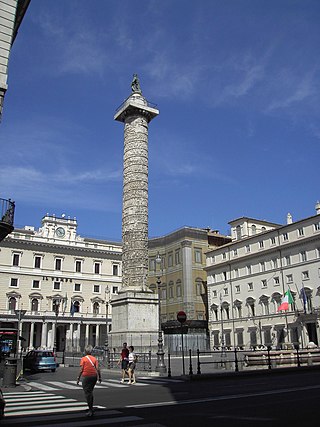
Colonna is the 3rd rione of Rome, identified by the initials R. III and located at the city's historic center in Municipio I. It takes its name from the Column of Marcus Aurelius in the Piazza Colonna, the rione's main square.

The Church of St. Louis of the French is a Catholic church near Piazza Navona in Rome. The church is dedicated to the patron saints of France: Virgin Mary, Dionysius the Areopagite and King Louis IX of France.

The Palazzo Venezia or Palazzo Barbo, formerly Palace of St. Mark, is a palazzo (palace) in central Rome, Italy, just north of the Capitoline Hill. The original structure of this great architectural complex consisted of a modest medieval house intended as the residence of the cardinals appointed to the church of San Marco. In 1469 it became a residential papal palace, having undergone a massive extension, and in 1564, Pope Pius IV, to win the sympathies of the Republic of Venice, gave the mansion to the Venetian embassy to Rome on the terms that part of the building would be kept as a residence for the cardinals, the Apartment Cibo, and that the republic would provide for the building's maintenance and future restoration. The palace faces Piazza Venezia and Via del Plebiscito. It currently houses the National Museum of the Palazzo Venezia.

San Martino ai Monti, officially known as Santi Silvestro e Martino ai Monti, is a minor basilica in Rome, Italy, in the Rione Monti neighbourhood. It is located near the edge of the Parco del Colle Oppio, near the corner of Via Equizia and Viale del Monte Oppio, about five to six blocks south of Santa Maria Maggiore.

Giuseppe Valadier was an Italian architect and designer, urban planner and archaeologist and a chief exponent of Neoclassicism in Italy.

Piazza Colonna is a piazza at the center of the Rione of Colonna in the historic heart of Rome, Italy. It is named for the marble Column of Marcus Aurelius, which has stood there since AD 193. The bronze statue of Saint Paul that crowns the column was placed in 1589, by order of Pope Sixtus V. The Roman Via Lata runs through the piazza's eastern end, from south to north.

Palazzo Braschi is a large Neoclassical palace in Rome, Italy and is located between the Piazza Navona, the Campo de' Fiori, the Corso Vittorio Emanuele II and the Piazza di Pasquino. It presently houses the Museo di Roma, the "Museum of Rome", covering the history of the city in the period from the Middle Ages through the nineteenth century.
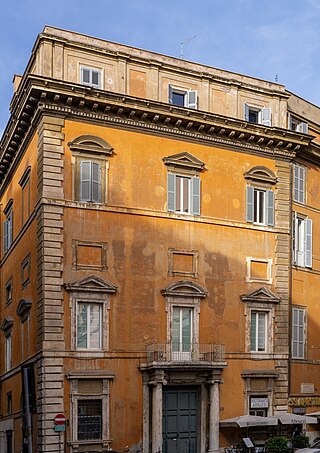
The Palazzo Muti is a large townhouse in the Piazza dei Santi Apostoli, Rome, Italy, built in 1644. Together with the neighboring Palazzo Muti Papazzurri, it originally formed part of a complex of adjoining palazzi and other houses owned by the Muti Papazzurri family. During the 18th century this entire range of buildings was, by courtesy of the pope, the residence of the Stuart dynasty while in exile in Rome. They were recognised by the Catholic Church as the rightful kings of Great Britain and Ireland. The Palazzo Muti should not be confused with the Palazzo Muti Papazzurri in the Piazza della Pilotta which was designed by Mattia de' Rossi in 1660.

Via della Conciliazione is a street in the Rione of Borgo within Rome, Italy. Roughly 500 metres (1,600 ft) in length, it connects Saint Peter's Square to the Castel Sant'Angelo on the western bank of the Tiber River. The road was constructed between 1936 and 1950, and it is the primary access route to the Square. In addition to shops, it is bordered by a number of historical and religious buildings – including the Palazzo Torlonia, the Palazzo dei Penitenzieri and the Palazzo dei Convertendi, and the churches of Santa Maria in Traspontina and Santo Spirito in Sassia.
Pietro Camporese the Elder (1726–1781) was an Italian architect.
Pietro Camporese the Younger (1792–1873) was an Italian neoclassical architect.
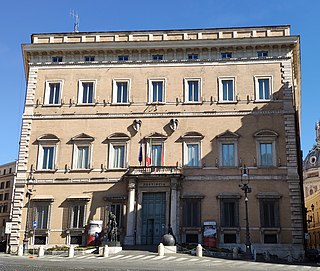
Palazzo Valentini is a palazzo in central Rome, Italy, not far from Piazza Venezia. Since 1873 it has been the base of the provincial and prefectural administration of Rome.
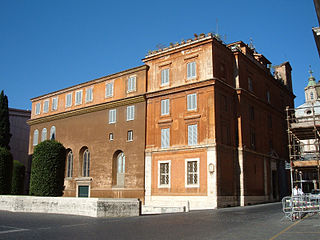
The Church of Our Lady of Mercy in the Teutonic Cemetery is a Roman Catholic church in the rione Borgo of Rome, Italy. It is located on the Via della Sagrestia.

Palazzo Aragona Gonzaga, also known as Palazzo Negroni, is a sixteenth-century palace in Rome, Italy. It was once the residence of Cardinal Scipione Gonzaga. During that time his cousin Luigi Gonzaga also lived there, as did the poet Torquato Tasso from 1587 to 1590. In the nineteenth century it belonged to the Galitzin family, and so is also known as Palazzo Galitzin.

The Istituto Nazionale per la Grafica is an Italian institute having the aim of preserving, protecting and promote a heritage of works providing documentary evidence of all types of graphic design: prints, drawings, photographs. The institute is located in Rome and is managed by the Directorate-General for Contemporary Landscape, Arts and Architecture of the Italian Ministry of Cultural Heritage and Activities.

Piazza d'Aracoeli is a square of Rome (Italy), placed at the base of the Capitoline Hill, in the Rione X Campitelli.

The Baths of Nero or Baths of Alexander were a complex of ancient Roman baths on the Campus Martius in Rome, built by Nero in either 62 or 64 and rebuilt by Alexander Severus in 227 or 229. It stood between the Pantheon and the Stadium of Domitian and were listed among the most notable buildings in the city by Roman authors and became a much-frequented venue. These thermae were the second large public baths built in Rome, after the Baths of Agrippa, and it was probably the first "imperial-type" complex of baths, with a monumental scale and symmetrical, axially-planned design. While in the sixteenth century the foundations of the caldarium were still visible, nothing else of the structure remains above ground except some fragments of walls incorporated into the structure of Palazzo Madama.
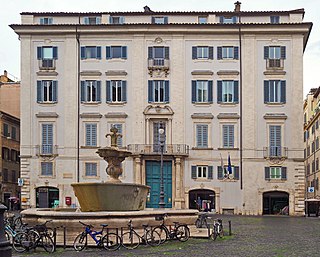
The Palazzo Fusconi-Pighini is a Renaissance-style palace located on Piazza Farnese #44 in the rione Regola of central Rome, Italy.




















